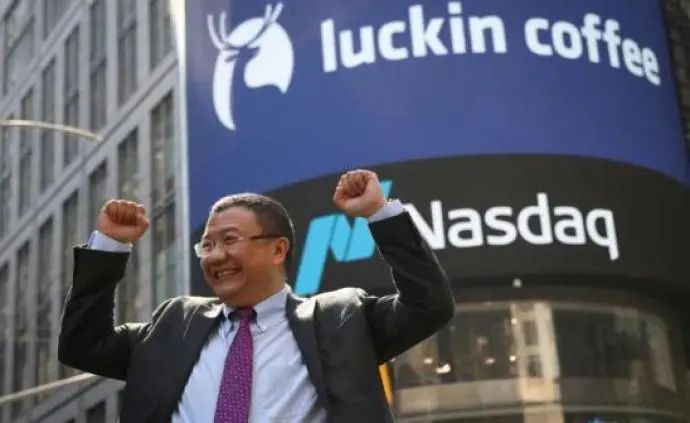The current situation of China ’s stock market for the past 20 years
Editor ’s note: This article comes from the WeChat public account , author: Zhang Jinjing.

In order to penetrate the mist caused by the counterfeiting of Chinese stock companies such as Ruixing, who to learn from, and a good future, you must first shake the camera to 20 years ago.
At that time, Wall Street Capital, represented by Goldman Sachs, was in an awkward state because the Chinese stocks that they supported with one hand fell to the bottom.
Twenty years ago, the first batch of Chinese stocks appeared in the US stock market. In addition to CDC catching up with a small climax, when Sina, NetEase and Sohu landed on the US capital market in 2000, all were without exception. Bleeding and listing, basically fell below the issue price.
It was also at this time that Lu Zhengyao, the founder of Ruixing Coffee, sold the domestic communications equipment agency business that he had been doing for five years and officially emigrated to Canada. According to his later memories, it was precisely because of the success of the Chinese stock market in the United States that he was constantly looking at some startup projects that may be listed.
However, with the bursting of the Internet investment bubble, short-selling companies have also gradually focused on Chinese concept stocks. Within six months, well-known short-selling groups have released survey and analysis reports on these Chinese concept stocks.
Although Wall Street and Oriental Capital, with Goldman Sachs as the core during that period, tried their best, these few stocks that now appear to be Chinese Internet leaders have fallen below $ 5 in December 2000. , Belongs to the scope of practical garbage stocks.

Goldman Sachs backed the Chinese stock market because it was the first big investment bank to enter Wall Street in China. After all, behind the listing of Chinese Internet companies in the United States around 2000, there is more or less the shadow of Goldman Sachs.
But even so, American investors still showed extreme distrust of Chinese Internet companies, especially after the financial reports of the first few years of listing of these Chinese Internet giants were disclosed, people found that almost all of them A money-burningbusiness.
So, the endless decline became a portrayal of the stock prices of these Chinese Internet companies in the United States.
In March 2001, the share prices of Sina, Sohu, and NetEase hovered between 1-2 dollars, which had reached the bottom line of delisting. On July 19, 2001, NetEase received a notice requesting suspension of trading from NASDAQ.
Goldman Sachs and Wall Street do n’t want the emerging markets they support, so the dividends disappear quickly.
According to an anonymous US dollar fund investor, Goldman Sachs and KPMG conducted a round of research on all Chinese stock companies during that time. They found that in order for US investors to accept the status quo of the development of Chinese stock companies, they must make a profit or find a profitable direction; of course, under this premise, they can also work on the preparation of financial reports, especially through the Research on different financial reporting systems has improved the performance of Chinese stock companies from financial data.
So, during that time, strengthening the training of the financial managers of China Prospective Shares was a top priority for entering China ’s big investment banks. The most important thing in the training was to invite the executives of the four major banks to speak specifically about China-US financial standards. The differences and skills in the preparation of annual reports.
The anonymous investor said that looking at what the investment bank training talks about now is exactly the same as the method used to convert costs out of Ruixing ’s financial report.
Of course, in order to strengthen the management of these Chinese stock companies, in 2001 Goldman Sachs conducted a wave of recruitment of Chinese students studying in the United States in the United States, with the aim of enriching the strength of Goldman Sachs ’related business teams in Asia.
Lai Hui, who has experience in major US investment bank mergers and acquisitions, joined Goldman Sachs Asia as an executive director at this time and became the de facto master of Goldman Sachs ’communication and support development strategy for Chinese stock companies.
As a result of this wave of operations, Sohu announced profit in the third quarter of 2002 one year later, and then Sina and NetEase also completed the realization of profit. Since then, these Chinese concept stocks have gradually risen in the shock and become the label of Chinese stocks in the United States.
Founders like Ding Lei and Zhang Chaoyang have finally reap the dividends of the capital market and become the first billionaires in the Chinese Internet.
At the same time, because their success stimulated many people, it opened the door for the next wave of Chinese stocks going to the United States.
A
Also in 2002, Xu Jie, the founder of Shenzhen cordless telephone giant “Wandley”, fled to the United States after accepting a bill of exchange and guarantee. The amount allegedly exceeded 600 million yuan.
After he arrived in the United States, he quickly invested in the capital market.
After the core company of China Provincial Stock announced profit and turned against the trend, he felt that he had found a business that could make profits quickly in the future. That is to buy shell resources in the US capital market and then transportChinese companies are listed in the United States through reverse acquisitions and receive commissions.
Because outside the NYSE and NASDAQ, there is a stock market called OTCBB in the United States. In this market, there are not as many laws and regulations as exchanges to manage. It is just a member’s quotation system, which is only used to trade certain listed companies’ stocks between various member units participating in this market.
The company listed in the OTCBB market can also be called a listed company or a public company in US law. Xu Jie caught this loophole.
On the one hand, he promised that all Chinese companies should go through the formalities of listing on the OTCBB securities market and pay all costs. On the other hand, he also promised to help companies complete the transfer from OTCBB to NASDAQ, mainly through the purchase The reverse acquisition of the Nasdaq-related shell resources was completed.
Xu Jie collects only the expenditure when purchasing shell resources and the shares after the successful listing on the NASDAQ. It is precisely because of such a charging method that it won the trust of many Chinese companies at the time.

However, after the successful listing of shares received by Xu Jie, in general, they will quickly throw profits within 2-3 months.
In order to meet the requirements of the US Securities Regulatory Commission for listed transfer companies, Xu Jie will send a team to help Chinese listed companies to organize their financial information and make all the documents required for listing. In this process, fraud is a very clear option for them.
Of course, because of the outstanding performance of Chinese concept stocks in the United States, since 2003, Chinese private companies have been eager for backdoor listings in the United States.
By 2010, when the US Securities Regulatory Commission widely penalized counterfeit Chinese listed companies, more than 300 Chinese private companies had gone to the United States for listing through shell purchases and reverse acquisitions.
Because of this wave of backdoor listings that began in 2003, the domestic venture capital community has become active. Lenovo, which just split, established its own capital company, and a young man named Liu Erhai joined Lenovo Investment this year.
Liu Erhai, a former senior investment manager and executive director, was promoted to managing director in 2007 and successfully took charge of Lenovo Investment. Since then, as a very important participant in China’s capital market, he has stepped onto the stage of history.

At that time, many of the projects that Lenovo Investment focused on and participated in were also in the process of going public in the United States. But compared to Xu Jie’s Sino-US capital, Lenovo Investment is still a younger brother in organizing Chinese companies to go public in the United States.
However, Chinese companies that successfully went public in the US with the help of Xu Jie did not live well.
Southern Weekend reporters discovered in a 2012 report survey that at that time Xu Jie ’s Sino-US Bridge Capital and Sino-US Strategic Capital operated a total of 9 Chinese companies to buy shells in the US for listing. Among them, 4 Chinese companies that successfully transferred from OTCBB to Nasdaq have been suspended or successfully hunted by short-selling funds, and the remaining 5 Chinese companies still exist on OTCBB. Trash unit.
There are still many intermediaries like Xu Jie who go to the US for listing. In order to successfully go public, many people choose financial fraud, which will bring a series of unpredictable serious consequences.
B
The financial crisis of 2008 has become a fuse for the exposure of the fraudulent incident of China Prospective Stock.
During the financial crisis, mainstream companies in all countries experienced performance declines or even losses. However, Chinese stocks listed in the United States at that time were almost all popular, and the good performance was unbelievable.
According to reports from Southern Weekend, in order to show that they are from the locomotive of the global economy, these listed companies often claim themselves as national names across the ocean. For example, China Education Group, China High Speed Media, China Green Agriculture, China Valve, China Clean Energy, etc.
In 2009, the prices of these “Chinese concept stocks” skyrocketed. According to data from China Economic Net, the share prices of Chinese companies listed in the United States in 2009 rose by an average of about 130%, and the stock prices of several star companies even rose by more than 1000% . But it is precisely because the financial report data is too ridiculous. Soon, these Chinese star listed companies were hunted down by US short-selling funds.
Ironically, according to statistics from Southern Weekend reporters, almost all Chinese concept stocks that have risen by more than 100% have been defeated by short-selling funds.
In the process of shorting, various financial fraud scandals of China Prospective Share shocked the United States. Especially for short companies, the data returned through on-site investigations is seriously inconsistent with the financial data published by all these star stock companies.

A survey company found on the spot that China High Speed Media claims to lay out advertising screens for all airports in China, which are just mobile TVs installed on buses at some airports. Another Chinese stock company urgently invited many U.S. The media went to visit the factory, but what I didn’t expect was that the survey company that issued the short report actually installed a camera outside the factory for monitoring. The image data showed that the factory was only operating at full load when all the media came to visit.
And the company named China Clean Energy, with its financial reports and beautiful flowers, has a very good profit, but the tax records that the investigators checked in the local tax department have been 0 for 10 consecutive years.
……
At the end of 2011, the US Securities and Exchange Commission issued an announcement to investigate. From March to May 2012, 18 Chinese companies were suspended from trading on the NASDAQ and NYSE, and four companies were ordered to delist.
Southern Weekend reporters found in the survey that by 2012, most of the more than 300 Chinese stocks listed in the United States through reverse acquisitions were mostly defrauded companies. Most of them are stranded to OTCBB, a stock market with low valuation, small trading volume and no free trading. Because the money defrauded by intermediaries is relatively small, these Chinese companies often admit that something is wrong.
But those Chinese companies that successfully transferred from OTCBB to the Nasdaq or the New York Stock Exchange use Fang Sanwen, the founder of “i US stocks”, to say, “No one is wrong.”
Because in fact, the vast majority of Chinese concept stocks do not satisfy the qualifications for transfer to these mainstream trading platforms, they cannot be successfully transferred to the market without financial fraud.
The key is that even after these companies successfully go public, they are still working tirelessly. According to incomplete statistics, many of the bosses of the Chinese stock companies that have successfully transferred to the US are from Fujian.
In 2010, Lu Zhengyao, who was strongly affected by the rush of Fujianese in the US stock market, founded the car rental in 2010.

At that time, Liu Erhai ’s Lenovo Capital gave him a strategic investment of 1.2 billion yuan, so that China ’s car rental company has rapidly expanded from a small 800-car company to the first car rental company in the industry with 50,000 cars.
Li Hui, also a capital promoter and former Goldman Sachs investment bank executive, became a partner of Lu Zhengyao during this time. I do n’t know if it was influenced by this professional. Lu Zhengyao abandoned the Fujianese fellow and bought a shell to go public., Decided to go to the US IPO to issue stocks.
Two years later, full of confidence Lu Zhengyao, Li Hui and Liu Erhai took 11 boxes of information and flew to Wall Street to open their own listings. However, they didn’t expect them to hit the wave of Wall Street’s crackdown on the stock market. At the road show, only 40% of the investment banks subscribed, and the amount of the subscription target was much lower than the intention value.
After three days and three nights of research, Lu Zhengyao and Liu Erhai in the US underwriting investment bank Goldman Sachs office decided to abandon the IPO.
This is also the most unforgettable impression left on him by the counterfeit Chinese stocks.
C
After the financial crisis, the Obama administration issued a series of policies to stimulate the economy, including opening the door for SMEs to go public. Especially for Internet companies, the relevant profit indicators and time limits have been further relaxed.
After 2015, this has greatly contributed to the boom of global venture capital and the listing of so-called unicorn companies.
Since then, Chinese companies have increasingly chosen to list IPOs in the US instead of reverse acquisitions.
If you want to become a unicorn to go public in the United States, you must boost your income in your daily operations, reduce costs, tell financial data and strategic stories beautifully, and gain recognition and attention from Wall Street investment banks.
During this time, Chinese companies listed in the US still have fraudulent behavior. It’s just not on financial data.
Because many Chinese companies go to the US for IPO, but not many can really enter the horizon of international investment banks. This has caused a considerable number of Chinese companies to issue stocks to the United States without finding an international investment bank that meets the order of magnitude to buy.
In order to ensure the success of the stock issuance, these listed Chinese companies will use the form of entrepreneurial teams, investors and underwriting investment banks to subscribe for the remaining shares. The stocks issued in this form have formed a fixed name in the international investment banking industry: “family and friends stocks.”
Incomplete statistics. In recent years, a considerable number of Chinese stocks listed in the United States have chosen the way of relatives and friends.
Because this number is too large, it has been heard that Nasdaq wants to restrict the listing of relatives and friends. However, on December 11, 2019, McKee, Nasdaq ’s head of global capital markets and chairman of the Asia Pacific region, said at a closed-door sharing meeting held by a Chinese investment bank that Nasdaq will not reject relatives and friends. However, these companies, whose major shareholders are all Chinese-funded companies or individuals, will be audited with stricter standards.
Of course, because this type of stock is stable, it will not be the target of short company hunting.
This time, Ruixing, who was hunted by muddy water, was the third successful venture of Lu Zhengyao, Liu Erhai and Li Hui. Two inadequate experiences and 2 before absorbingAfter the lesson that went public in the US in 012, Ruixing Coffee became a benchmark project aimed at the US IPO.

“Now looking at the setting of Ruixing Coffee when it started a business, it was prepared to meet all the conditions for listing in the United States,” commented some celebrities in the venture capital circle.
After all, Li Hui, who has Goldman Sachs investment experience, knows what kind of data US investment banks care about, and Liu Erhai ’s network can find a lot of idle funds for Lu Zhengyao, plus Lu Zhengyao ’s management experience tempered by three entrepreneurial ventures, Ruixing Coffee, the freak that rushed into the capital market 18 months after its establishment, appeared like this.
Compared with the unsuccessful listing of car rental in China, Ruixing Coffee was equipped with a strong team of consultants from the beginning. The big investment bank increased the law firm plus such an issuance method, which also laid the foundation for the successful listing of Ruixing Coffee.
Rui Xing explodes now, and it is only a matter of time before the delisting takes place. The IPO factories of Lu Zhengyao and Audio-Technica should be discontinued. However, as long as there are people where there are rivers and lakes, the history of financial “beauty” and even fraud in the Chinese stock market will continue to be writable in another 20 years.
References
1. “Hunting Chinese counterfeit stocks-why are Chinese concept stocks splashing into the US capital market?” 》 Southern Weekend 2012
2. The public account “Pang Guanzheqing” of “The Fraud and Short Sales of the Chinese Prospective Stocks I Have Experienced” April 8, 2020
3. “Anti-Internet Tycoon Lu Zhengyao” Phoenix Technology 2016
4. “Lu Zhengyao’s Theory of Speeding Capital” Business 2013 2013
5. “Bubble Pusher Liu Erhai” public account Sanyan Finance April 7, 2020
6. “Interview with Dazheng Capital Li Hui: Why did I invest in Lucky? 》 Liyun.com May 2019
7. “Sino-US Bridge Capital Evaporation: Having Controlled the Ten Thousand Billion Market Value of China’s Prospective Shares” Huaxia Times July 2012